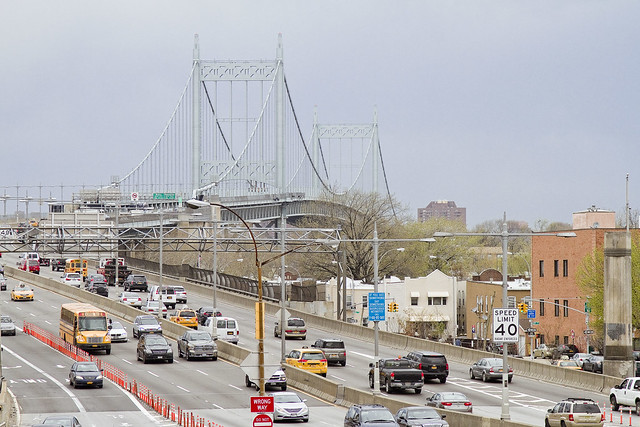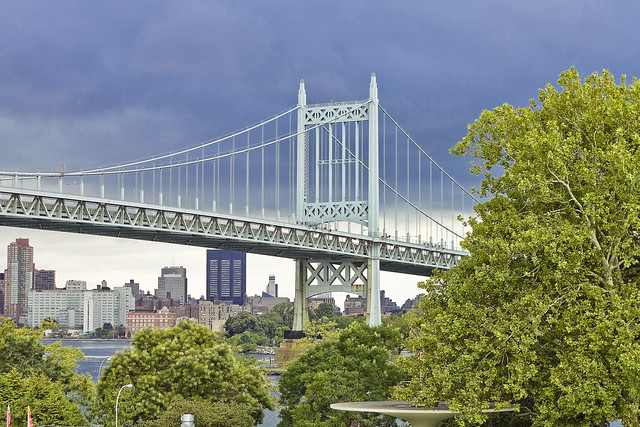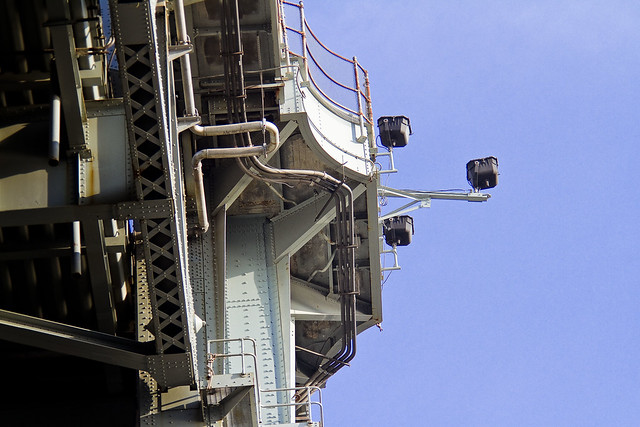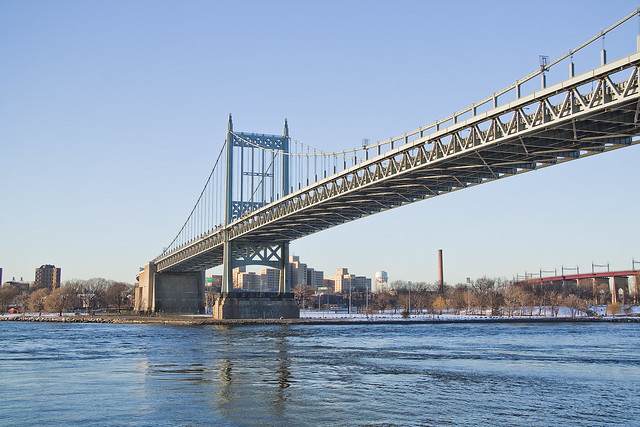half smile
Happy Birthday, Triborough Bridge, you’re now an Octogenarian.
– photo by Mitch Waxman
Triborough Bridge, aka Robert F Kennedy Bridge, in Astoria, Queens opened on this day in 1936. It was 80 years ago today that Bob Moses taught the band to play, as it were. The bridge complex (there’s actually three spans that compose Triborough, pictured in today’s post is the suspension bridge section which connects to Astoria) was designed by the team of Othmar Amman and Aymar Embury ll. Construction on the thing began on the so called “Black Friday” of 1929 which signaled the beginning of the Great Depression.
from wikipedia
Construction began on Black Friday in 1929, but soon the Triborough project’s outlook began to look bleak. Othmar Ammann, who had collapsed the original design’s two-deck roadway into one, requiring lighter towers, and thus, lighter piers, saving $10 million on the towers alone, was enlisted again to help guide the project. Using New Deal money, it was resurrected in the early 1930s by Robert Moses, who created the Triborough Bridge Authority to fund, build and operate it. The completed structure was opened to traffic on July 11, 1936.
The total cost of the bridge was more than $60 million, one of the largest public works projects of the Great Depression, more expensive even than the Hoover Dam. The structure used concrete from factories from Maine to Mississippi. To make the formwork for pouring the concrete, a whole forest on the Pacific Coast was cut down.
– photo by Mitch Waxman
The national economic downturn caused progress on the project to grind to a halt, until Robert Moses took interest in the project and inserted himself. For the vast majority of living New Yorkers, all that we’ve ever known of this City is what Moses made of it. He gave our grandparents, parks, highways, and bridges – for awhile in the mid 20th century he was the de facto spokesman for “progress.” He destroyed entire neighborhoods and ruled his empire like a tyrant, as well. We all live in the “House of Moses.”
Moses wanted to build parkways and expressways, ultimately, and proposed to NY State that his high speed roads could serve as the approaches for the Triborough. His “Grand Central Parkway,” “Astoria Blvd.,” “East River Drive (now called FDR drive),” “Whitlock Avenue,” and “Eastern Blvd.” projects were all built simply to serve the needs of the automobile and feed traffic to Triboroughs Toll Booths. Due to the roads in Queens, Manhattan, and the Bronx, Triborough soon became the greatest machine for magnifying traffic that NYC that the world had ever seen. Traffic magnified year after year, and every single one of those vehicles had to pay tolls.
Moses, who helped author the modern constitution of NY State when he worked for Governor Al Smith, conducted business in the shadowy world of an “authority,” or public benefit corporation, which he had christened as the “Triborough Bridge Authority.” Moses literally wrote the laws governing such “authorities” and was able to game the system at every step. Today his authority is called the Triborough Bridge and Tunnel Authority, which was incorporated into the Metropolitan Transportation Authority (MTA) by Governor Nelson Rockefeller in 1968.
Today, Triborough is officially part of the MTA Bridges and Tunnels unit, but it still carries an obscene number of vehicles and collects shed loads of cash at those toll booths.
from wikipedia
Robert Moses (December 18, 1888 – July 29, 1981) was the “master builder” of mid-20th century New York City, Long Island, Rockland County, and Westchester County, New York. As the shaper of a modern city, he is sometimes compared to Baron Haussmann of Second Empire Paris, and is one of the most polarizing figures in the history of urban planning in the United States. He changed shorelines, built bridges, tunnels and roadways, and transformed neighborhoods forever. His decisions favoring highways over public transit helped create the modern suburbs of Long Island and influenced a generation of engineers, architects, and urban planners who spread his philosophies across the nation.
Never elected to public office, Moses was responsible for the creation and leadership of numerous public authorities which he could control without having to answer to the general public or to elected officials. It is due to Moses that there are a disproportionate number of public benefit corporations in New York state, which are the prime mode of infrastructure building and maintenance in New York, and are currently responsible for 90% of the state’s debt. As head of various authorities, he controlled millions in income from his projects’ revenue generation, such as tolls, and he had the power to issue bonds to borrow vast sums, allowing him to initiate new ventures with little or no approval from legislative bodies, bypassing the usual power of the purse as it normally functioned in the United States, and the cumbersome process of citizen comment on major public works.
– photo by Mitch Waxman
The jewel in Robert Moses’s crown was always mighty Triborough, and it was the center of his construction empire. Using the proceeds from the tolls on the bridge, and the unique freedom from the election cycle which Mayors and Governors were and are beholden to, the “authority” became a shadow government. Moses was able to wield incredible amounts of credit through the issuance of attractively priced municipal bonds guaranteed by Triborough’s millions in toll proceeds. This made him very popular with banking interests, and the huge amounts of cash and credit he had allowed Moses to build anything he wanted. Wherever he wanted.
Moses’s offices were on Randall’s Island, adjoining the counting rooms for the bridges tolls.
from wikipedia
Originally named the Triborough Bridge Authority, the authority was created in 1933 as a public-benefit corporation by the New York State Legislature. It was tasked with completing construction of the Robert F. Kennedy (Triborough) Bridge, which had been started by New York City in 1929 but had stalled due to the Great Depression.
Under the chairmanship of Robert Moses, the agency grew in a series of mergers with four other agencies:
- Henry Hudson Parkway Authority, in 1940
- Marine Parkway Authority, in 1940
- New York City Parkway Authority, in 1940
- New York City City Tunnel Authority, in 1946
With the last merger in 1946, the authority was renamed the Triborough Bridge and Tunnel Authority.
Generating millions of dollars in toll revenue annually, the TBTA easily became a powerful city agency as it was capable of funding large capital projects. From the 1940s-60s, the TBTA built the Battery Parking Garage, Jacob Riis Beach Parking Field, Coliseum Office Building and Exposition Center and East Side Airlines Terminal, as well as many parks in the city.
– photo by Mitch Waxman
There are few structures in NYC which are as staggering in scale as Triborough. According to Moses biographer Robert Caro’s definitive book “the Powerbroker” – “more than five thousand men would be working at the site, and these men would only be putting into place the materials furnished by the labor of many times five thousand men; before the Triborough Bridge was completed, its construction would have generated more than 31,000,000-man hours of work in 134 cities in twenty states.”
from mta.info
The bridge’s 3.5 miles of roadway include a suspension span to Queens, a vertical lift bridge to Harlem in Manhattan and a fixed truss bridge to the Bronx-all converging at a huge traffic junction on Randall’s Island. The Queens span is 1,380–feet long and has four lanes in either direction. It has a clearance of 135 feet above the river, high enough for ships to pass under. The Harlem River lift span (as it is commonly called) in Manhattan has three lanes in either direction and moves its center section up and down like an elevator to allow tall marine traffic to pass. The Bronx crossing has three lanes in either direction over its framework of steel beams that form interconnected triangles, making the structure light and strong.
– photo by Mitch Waxman
There is a school of thought out there which suggests that the heroic performance of American industry during the Second World War was due to the industrial orders which Moses placed during the 1930’s for materials needed to construct the bridge and its approaches. The steel factories of Pittsburgh, concrete factories up and down the East Coast of the United States, the railroads and cargo ships which carried the material into NYC – all served to put American industry back to work. Think about the corollary supply lines for everything that was needed to make it – coal, iron, coke etc. If Pearl Harbor would have occurred in a world in which there had been no Triborough project, it would have taken as long as two years to stoke the furnaces and rehire a work force to build the weapons of WW2.
– photo by Mitch Waxman
Triborough, as the name implies, touches down in three of the boroughs of NYC. It connects Manhattan, Bronx, and Queens. The East River suspension bridge spans a part of the river called Hells Gate. It also sits on one of the lesser islands of the archipelago of New York Harbor, Wards Island. Wards has been connected to its neighbor, Randall’s Island during the 20th century by landfill, but they used to be distinct land masses separated by a tidal strait.
Wards Island is kind of a weird place.
from wikipedia
After the war ended, Jaspar Ward and Bartholomew Ward took ownership of the island that later carried their surname. Although a small population had lived on the island since as early as the 17th century, the Ward brothers developed the island more heavily by building a cotton mill and building the first bridge to cross the East River in 1807, connecting the island with Manhattan at 114th Street.
The bridge, paid for by Bartholomew Ward and Philip Milledolar, was a wooden drawbridge. The bridge lasted until 1821, when it was destroyed in a storm.After the bridge was destroyed, the island was largely abandoned until 1840, when the island was transformed into a dumping ground for everything unwanted in New York City. Between 1840 and 1930 the island was used for:
- Burial of hundreds of thousands of bodies relocated from the Madison Square and Bryant Park graveyards.
- The State Emigrant Refuge, a hospital for sick and destitute immigrants, opened in 1847, the biggest hospital complex in the world during the 1850s.
- The New York City Asylum for the Insane, opened around 1863.
- An immigration station from 1860 until the 1892 opening of Ellis Island.
- Manhattan State Hospital, operated by the New York State Department of Mental Hygiene when it took over the immigration and asylum buildings in 1899. With 4,400 patients, it was the largest psychiatric institution in the world. The 1920 census notes that the hospital had a total of 6045 patients. It later became the Manhattan Psychiatric Center.
– photo by Mitch Waxman
Shades of “Arkham Asylum” on Wards Island (from the Batman mythology) notwithstanding, Triborough – along with the Hell Gate Bridge – is the backdrop to life here in Astoria. Due to the rapacious real estate development currently underway in western Queens, this won’t last for long as residential towers continue to rise all along the waterfront. The view above is from the Queensboro Bridge, incidentally, looking north.
from omh.state.ny.us
Kirby Forensic Psychiatric Center, a maximum security hospital of the New York State Office of Mental Health (OMH), opened in 1985 and provides secure treatment and evaluation for the forensic patients and courts of New York City and Long Island. Most patients are received through the courts under Criminal Procedure Law (CPL) or through the OMH Commissioner’s office via the New York State Code of Rules and Regulations (NYSCRR) regarding hospitalization of the mentally ill.
Treatment is provided in accordance with the current standards of professional care outlined by the Joint Commission of Accreditation of Health Organizations (JCAHO) and is carried out with respect for each patient’s privacy and rights, in agreement with his/her level of functioning and need for security. KFPC has an active staff education program as well as academic affiliations with several metropolitan area colleges and universities, to help assure quality treatment and state of the art care.
and from wikipedia
The Manhattan Psychiatric Center is a New York-state run psychiatric hospital on 125th Street on Ward’s Island in New York City. As of 2009 it had 509 beds. The current building is 14-stories tall.
The hospital’s roots date to 1848 when Ward’s Island was designated the reception area for immigrants. Some additional structures were originally part of Blackwell’s Island Lunatic Asylum, which opened around 1863.
The building was significantly enlarged in 1871, and a Kirkbride Plan style building was built. After the immigration entry shifted to Ellis Island in 1892 the state took it over from Manhattan in 1899 and expanded it even further. At the time, it had 4,400 beds and was the largest psychiatric hospital in the world.
At the time it was one of two psychiatric hospitals for residents of Manhattan that had been take over by the state. The other psychiatric hospital would become the Central Islip Psychiatric Center in Central Islip, New York. Both hospitals were referred to as Manhattan State Hospital.
It later became the Manhattan Psychiatric Center. The facility is currently run by the New York State Office of Mental Health.
– photo by Mitch Waxman
As a rule, I don’t use the modern appellations for Queensboro (Ed Koch) and Triborough (Robert F. Kennedy). I will, once the Brooklyn Bridge is renamed for Michael Bloomberg or Chuck Schumer.
Happy 80th, mighty Triborough.
Upcoming Events and Tours
Tuesday, July 12, 7:00 p.m. – 10:00 p.m. –
LICHenge, with Atlas Obscura and the
Hunters Point Park Conservancy. Click here for more details.
Saturday, July 16, 11:15 a.m. – 12:45 p.m. –
FREE Newtown Creek Boat Tour,
with Waterfront Alliance (note- WA usually releases tix in batches).
Click here for more details.
Saturday, July 23, 11:00 a.m. – 1:00 p.m. –
Calvary Cemetery Walking tour,
with Brooklyn Brainery. Click here for more details.
Tuesday, July 26, 6:30 p.m. – 8:30 p.m. –
Glittering Realms Walking tour,
with NYC H2O. Click here for more details.
Wednesday, July 27, 1st trip – 4:50 p.m. 2nd trip – 6:50 p.m. –
2 Newtown Creek Boat Tours,
with Open House NY. Click here for more details.
“follow” me on Twitter- @newtownpentacle













Ironically,Robert Moses never had a New York State Driver’s License.He was limo’d everywhere.
Richy Franke
July 11, 2016 at 12:01 pm
As always, I appreciate you capturing and archiving a “view” before it goes, or at least is only accessible to those at the top. Power Broker is a great read — more people don’t appreciate the good Moses did, Jacobs’ legitimate criticisms of him not withstanding, I doubt the City would be as great as it is without his efforts. Certainly, more people could afford to credit him and the TBTA with the creation of so many parks.
Tommy
July 13, 2016 at 1:14 pm
[…] commemorating the day on which the steel of the bridge was finished, for instance. As an aside, here’s a post on it’s neighbor to the south, the Triborough Bridge, and one of the many where a humble narrator described ships and other […]
great bridge | The Newtown Pentacle
March 9, 2017 at 11:01 am